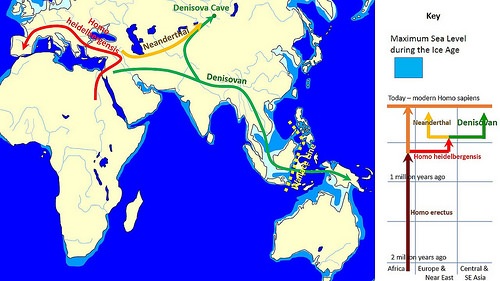
AMERICAN ASSOCIATION FOR THE ADVANCEMENT OF SCIENCE—Modern Melanesians harbor genetic components passed on from Denisovans, a new study* suggests. In the past, ancestors of many modern human populations interbred with other hominin species that have since become extinct, such as the Neandertals and Denisovans. Mapping the gene flow of surviving genetic sequences from these species, as well as other species of hominin, helps shed light on how past interbreeding has affected human evolution. While previous studies have documented Neandertal gene flow in modern humans, much less is known about the characteristics of Denisovan DNA that persist in humans today. To gain more insights, Benjamin Vernot et al.* analyzed the genomes of 1,523 individuals from around the world, including 35 individuals from Northern Island Melanesia, in Papua New Guinea. Their results showed that while all non-African populations surveyed inherited roughly 1.5-4% of their genomes from Neandertals, Melanesians were the only population that also had significant Denisovan genetic ancestry, representing between 1.9% and 3.4% of their genome. The researchers then mapped out the genetic flow of Neandertal and Denisovan sequences, finding that Neandertal admixture, or gene flow, occurred at least three distinct times in human history. In contrast, Denisovan admixture likely only occurred once. Further analysis revealed that certain regions of the modern human genome are particularly depleted of these archaic lineages, including those that play a role in the developing cortex and adult striatum. These findings provide new insights into human evolution and gene flow.
_______________________________________
Map showing spread and evolution of Denisovans. John D. Croft, Wikimedia Commons
Article Source: American Association for the Advancement of Science news release.
_____________________________________________________
*”Excavating Neandertal and Denisovan DNA from the genomes of Melanesian individuals,” by B. Vernot; S. Tucci; J.G. Schraiber; A.B. Wolf; R.M. Gittelman; R.C. McCoy; J. Wakefield; J.M. Akey at University of Washington in Seattle, Washington; S. Tucci; S. Pääbo at University of Ferrara in Ferrara, Italy; J. Kelso; M. Dannemann; S. Grote at Max-Planck-Institute for Evolutionary Anthropology in Leipzig, Germany; H. Norton at University of Cincinnati in Cincinnati, OH; L.B. Scheinfeldt at Coriell Institute for Medical Research in Camden, NJ; D.A. Merriwether at Binghamton University in Binghamton, NY; G. Koki at Institute for Medical Research in Goroka, Papua New Guinea; J.S. Friedlaender at Temple University in Philadelphia, PA.
_____________________________________________________

______________________________________________
Travel and learn with Far Horizons.
____________________________________________
This richly illustrated issue includes the following stories: Recent findings shedding new light on the whereabouts of the remains of Philip of Macedon, father of Alexander the Great; how an archaeologist-sculptor is bringing bones of the dead back to life; archaeologists uncovering town life at the dawn of civilization; an exclusive interview with internationally acclaimed archaeologist James M. Adovasio about what makes the Meadowcroft Rockshelter prominent in the ongoing search for the first Americans; what archaeologists are finding at the site of the ancient city of Gath, the home town of the biblical Philistine giant, Goliath; and how scientists are redrawing the picture of human evolution in Europe. Find it on Amazon.com.








